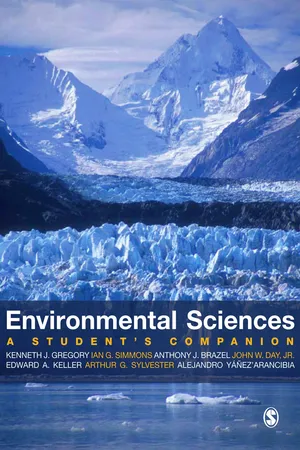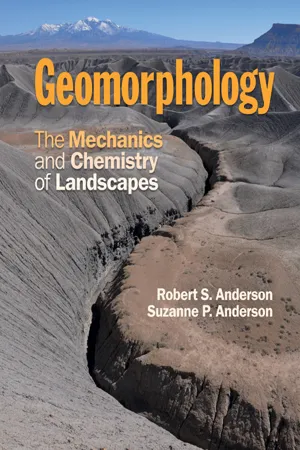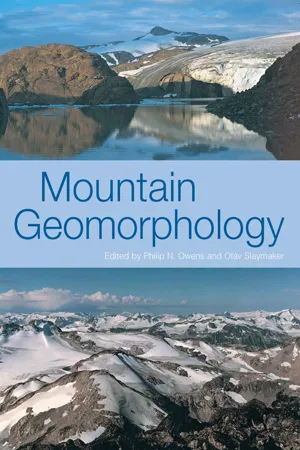Geography
Subaerial Processes
Subaerial processes refer to the various natural processes that occur at or near the Earth's surface, such as weathering, erosion, and mass movement, which are primarily driven by atmospheric conditions. These processes are important in shaping the Earth's landforms and landscapes, and they are influenced by factors such as climate, topography, and vegetation.
Written by Perlego with AI-assistance
Related key terms
1 of 5
6 Key excerpts on "Subaerial Processes"
- eBook - PDF
- Shalinee Naidoo(Author)
- 2023(Publication Date)
- Delve Publishing(Publisher)
GEOMORPHOLOGICAL PROCESSES, ENVIRONMENTAL INTERACTIONS, CYCLES, AND SYSTEMS 3 CONTENTS 3.1. Weathering ....................................................................................... 22 3.2. Formation of Geological and Hydrological Structures ....................... 25 CHAPTER Transnational Water Management for Beginners 22 Geomorphological processes such as weathering and erosion are responsible for the origin of landforms. These processes while often viewed in a negative light are actually responsible for the constant shaping of the Earth’s surface and the generation of sediments. 3.1. WEATHERING As soon as rock has formed, it becomes vulnerable to changes in structure as a result of the action or influence of certain environmental factors. Common disintegration processes include wind, water, and rain which usually have an effect on rocks leading to the weathering away over long periods of time. These processes result in a release of pressure on the rocks either directly or indirectly, which in turn causes the rocks to fracture and break apart. It is also good to remember that these processes are not the only mechanical processes leading to weathering. Biological activity, extreme weather patterns, and agents of erosion like wind and ice are common examples of environmental forces that influence the breakdown and loosening of surrounding rocks and soils. Weathering is therefore defined as a disintegration process whereby rocks or soil is dissolved or worn away into much smaller pieces due to changes in environmental conditions. Weathering processes can be physical and chemical and often begins below the surface, away from elements of weather. Weathering processes below ground begin with the natural pores and fissures in rocks being penetrated by air and water. The air contains oxygen and carbon dioxide while the water consists of a variety of compounds that have dissolved in it, rendering the solution acidic. - eBook - PDF
Environmental Sciences
A Student′s Companion
- K J Gregory, Ian Simmons, Anthony Brazel, John W Day, Edward A Keller, Alejandro Yanez-Arancibia, Arthur G Sylvester(Authors)
- 2008(Publication Date)
- SAGE Publications Ltd(Publisher)
(Cont'd) 236 Processes and Dynamics as karst processes exclusive to limestone terrain, and some processes such as subsidence can occur in periglacial environments or be the result of tectonic processes. All processes can be envisaged as involving expenditure of energy acting on materials (rock and solids, water, air, organic materials) to produce products which can include landforms, soil profiles or vegeta-tion types. Several processes may be grouped together, especially when studying them in terms of basic laws, so that the principles of fluid flow and fluid mechanics apply to fluvial, coastal, aeolian and glacial processes. Throughout environmental sciences, data is required on Earth surface processes and some is collected by national and international organizations such as hydrological and oceanographic data. In addition data is obtained in the course of national surveys for example of soil types or from vegetation surveys. However if data is not already available it can be obtained empirically by field measurements often through carefully designed experiments such as experimental areas or by remote sensing; by laboratory investigations which include scaled down environ-mental models, of a section of coast for example; and by historical techniques, which use a method of deducing change over time from records or archive materials, such as historical maps of the position of a glacier margin at different dates. Earth surface processes are combined in particular ways in different environments and so process domains are zones in which particular processes operate. Some processes such as glacial processes are confined to particular zones whereas others such as fluvial, aeolian and mass wasting can occur in most regions of the world. - eBook - PDF
- James Shipman, Jerry Wilson, Charles Higgins, Bo Lou, James Shipman(Authors)
- 2020(Publication Date)
- Cengage Learning EMEA(Publisher)
(See the chapter-opening quotation.) Important geologic processes take place on the ocean floor, which accounts for about 70% of the Earth’s surface. Therefore, waves and ocean currents along with shoreline and seafloor topography are also considered in this chapter. Chapter Outline 23.1 Weathering 692 Conceptual Q&A 23.1 Moon Weathering 694 23.2 Erosion 696 23.3 Groundwater 702 Highlight 23.1 The Earth’s Largest Crystals 703 Conceptual Q&A 23.2 Powering the Hydrologic Cycle 704 23.4 Shoreline and Seafloor Topography 707 Highlight 23.2 The Highest Tides in the World 708 < Arizona’s Grand Canyon is a vivid example of erosion. Copyright 2021 Cengage Learning. All Rights Reserved. May not be copied, scanned, or duplicated, in whole or in part. Due to electronic rights, some third party content may be suppressed from the eBook and/or eChapter(s). Editorial review has deemed that any suppressed content does not materially affect the overall learning experience. Cengage Learning reserves the right to remove additional content at any time if subsequent rights restrictions require it. 692 Chapter 23 ● Surface Processes 23.1 Weathering Key Questions ● ● What are the two basic types of weathering processes? ● ● How is chemistry associated with weathering? Weathering is the process of breaking down rock on or near the Earth’s surface. The rate of weathering depends on a number of factors, such as the type of rock, moisture, tem- perature, and overall climate. Mechanical weathering involves the physical disintegration or fracture of rock, primarily as a result of pressure. For example, a common type of mechanical weathering in some regions is frost wedging. When rock solidifies or is altered by deposits, heat, or pressure, internal stresses are produced in it. One common result of these stresses is cracks or crevices in the rock, called joints. Joints provide an access route for water to penetrate rock. - eBook - PDF
Geomorphology
The Mechanics and Chemistry of Landscapes
- Robert S. Anderson, Suzanne P. Anderson(Authors)
- 2010(Publication Date)
- Cambridge University Press(Publisher)
C H A P T E R 5 Atmospheric processes and geomorphology Blow, winds, and crack your cheeks! rage! blow! You cataracts and hurricanes, spout Till you have drench’d our steeples, drown’d the cocks! William Shakespeare (King Lear) 96 We review those aspects of the climate system that are relevant to the study of geomorphology. The primary driver of geomorphic processes is the atmosphere. This is remarkable given its thickness and density. The atmosphere delivers the winds and precipitation in storms, it determines the temperatures, and it sets the pace of the hydrologic cycle that in turn dictates the vegetation of a region. All of these vary dramatically with location on the Earth’s surface, largely because the solar radiation that drives the climate system is delivered non-uniformly on the surface. In addition, the climate varies strongly in time. The most obvious temporal variation, and the most relevant to the current state of the landscape, is that associated with the ice ages of the last two to three million years. In this chapter Clearing of storm above Black Glacier, at crest of Mt Olympus, Washington. Snowfall is high here as Pacific storms collide with the high topography of the Olympic Mountains (photograph by R. S. Anderson). 97 Climate is a synthesis of the weather at a point or in a region of the Earth’s surface (Hartmann, 1994 ). The climate at any point on the Earth must be described in a statistical way: at the very least we must describe both the mean and the variation about that mean. The short-term variations are what we call weather, which is driven by the storms embedded in the general circulation pattern of the atmosphere, and it is these storms that deliver the precipitation to the Earth’s surface. We will review the basic physics and chemis-try of the atmosphere, and will discuss the climate and how it varies over the Earth. - eBook - ePub
- Phil Owens, Olav Slaymaker(Authors)
- 2014(Publication Date)
- Routledge(Publisher)
Scheidegger (1998) has explored this topic in terms of the ‘geotectonic predesign’ of landslides. As bedrock formations are unroofed and exposed by erosion, stress fields and unloading features develop in mountain masses and valley walls. They also influence slope safety, especially the risk of catastrophic rockwall failures (see below). These and other geomorphic hazards are intensified where stream incision and slope stability are affected by rapid uplift (Shroder, 1989; Burbank et al., 1996). Orogeny is also associated with the main concentrations of earthquakes and volcanoes. These, large and frequent weather fluctuations, glaciation and sensitivity to climate change, can further increase the incidence and magnitude of dangerous Earth surface processes. Orographic effects involve the influence of mountainous topography on subaerial conditions. They act mainly through topoclimate, i.e., distinctive climatic zoning by elevation and the orientation of mountain slopes. The former, sometimes referred to as verticality, or the upslope variation in conditions with elevation, affects temperature, including the incidence of freeze-thaw, precipitation and its phase, cloudiness and intensity of sunshine. In risk terms, verticality serves to locate and intensify Earth processes and to complicate the adaptive context through the diversity of hazards, their spatial and temporal variability. Slope orientation modifies the extent and elevation range of altitudinal zones. This occurs in two ways: in relation to atmospheric circulation (windward versus lee slopes), and/or with aspect relative to the sun as a function of latitude. Shading by intervening mountain ridges adds further variability. Equally important is the way seasonality of conditions and processes varies in each elevation zone and by slope orientation. Many geomorphic processes, notably avalanches, debris flows and floods, have a different seasonal incidence or severity in different altitudinal zones (Hewitt, 1993b) - eBook - ePub
Groundwater as a Geomorphic Agent
Binghamton Geomorphology Symposium 13
- R.G. LaFleur(Author)
- 2020(Publication Date)
- Routledge(Publisher)
Many of the geomorphological consequences of soil moisture are so obvious as to require no more than passing mention. Without soil moisture, there would be little or no vegetation. According to many authorities, this would cause a diminution in the amount of oxygen in the atmosphere, and this in turn would entail a decrease in oxidation. Certainly, both fluvial and aeolian erosion would be much more pronounced than they now are. The many extant accounts of accelerated soil erosion (see, e.g. Duce 1918, Ratcliffe 1936, 1937, Jacks & Whyte 1939, Sharpe 1941, Holmes 1946, Vogt 1953, Bennett 1960) only begin to convey the importance of plants in protecting the land surface. Unfortunately, the same point is made even more succinctly and poignantly in the landscape over extensive areas of several continents, particularly in the so-called Third World (Fig. 5.1). Russell (1958) has pointed out that without a soil cover, for the formation of which moisture and organisms that are moisture dependent are essential, the landscape would present a very different face, and that in particular, rounded, graded hillslopes would be less common than they now are. And so on – soil moisture has several indirect or general geomorphological effects.Specific and direct geomorphological effects of subterranean moisture can be considered under several distinct headings. First, water is a vital component in many important types of rock weathering. For most purposes, weathering may conveniently be defined as the disintegration or alteration of rocks at and near the Earth’s surface, and in the range of temperatures found there. In this context, the complex of processes assumes considerable importance as a necessary precursor to erosion and hence to deposition.Figure 5.1 This gullying in the Transkei, southern Africa, is due, in part, to the deliberate felling of trees for use as domestic fuel, partly to the regular and long-continued tramping of people and stock from the safer hill-top settlements to the water supply in the valley floor.Even in temperate lands, however, it has a wider significance. Bloom (1978, p. 103) states, “Weathering does not make landforms, but only altered or broken rocks from which landforms are shaped.” Undoubtedly, the implied destructive aspect of weathering is very important the world over, but many landforms directly reflect the exploitation by erosional agencies of contrasts in susceptibility caused by weathering. The lower or lateral limit of weathering is called the weathering front (Mabbutt 1961a), and the front exposed by the stripping of the regolith is an etch surface.
Index pages curate the most relevant extracts from our library of academic textbooks. They’ve been created using an in-house natural language model (NLM), each adding context and meaning to key research topics.





